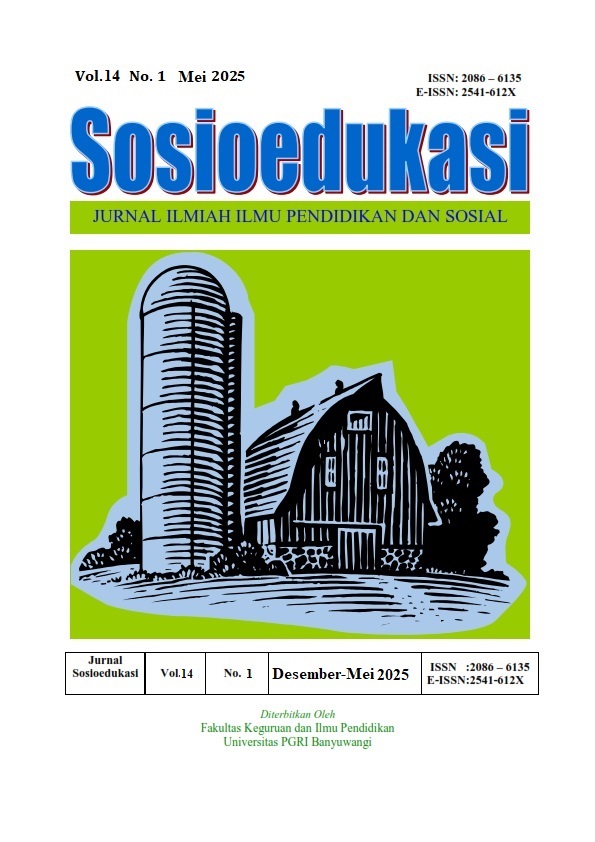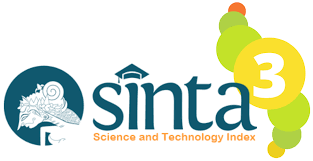THE CORRELATION BETWEEN STUDENTS’ MOTIVATION AND ENGAGEMENT IN LEARNING ACTIVITY USING ChatGPT
DOI:
https://doi.org/10.36526/sosioedukasi.v14i1.5413Keywords:
ChatGPT, Student Motivation, Student Engagement, Learning Activities, Artificial IntelligenceAbstract
This research explores the correlation between students' motivation and engagement in learning activities using ChatGPT, an AI-based interactive tool. It focuses on how ChatGPT influences students' intrinsic and extrinsic motivation, as well as their behavioral, emotional, and cognitive engagement. A quantitative correlational design was employed, involving 385 students from Universitas Muhammadiyah Kalimantan Timur selected through simple random sampling. Data were collected using a validated Likert-scale questionnaire based on Self-Determination Theory and Fredricks’ engagement framework. The results indicated that students demonstrated moderately high levels of motivation (M = 29.65) and high levels of engagement (M = 32.52) when learning with ChatGPT. Spearman’s rho analysis revealed a moderate and statistically significant correlation (ρ = .559, p < .01) between motivation and engagement. These findings suggest that higher levels of motivation are associated with increased engagement in AI-supported learning activities. The study concludes that ChatGPT can effectively enhance both motivation and engagement, offering practical insights for educators and curriculum designers in developing more interactive, personalized, and student-centered learning experiences. Integrating ChatGPT into educational contexts supports the advancement of digital pedagogy and promotes more meaningful learning in 21st-century classrooms.
References
Afkarin, M. Y., & Asmara, C. H. (2024). Investigating the Implementation of ChatGPT in English Language Education. Journey: Journal of English Language and Pedagogy, 7(1), 57–66. https://doi.org/10.33503/journey.v7i1.4000
Alamer, A. (2022). Basic Psychological Needs, Motivational Orientations, Effort, and Vocabulary Knowledge. Studies in Second Language Acquisition, 44(1), 164–184. https://doi.org/10.1017/S027226312100005X
Ali, J. K. M., Shamsan, M. A. A., Hezam, T. A., & Mohammed, A. A. Q. (2023). Impact of ChatGPT on Learning Motivation.
Alizadeh, M. (2016). The Impact of Motivation on English Language Learning.
Almasri, F. (2024). Exploring the Impact of Artificial Intelligence in Teaching and Learning of Science: A Systematic Review of Empirical Research. Research in Science Education, 54(5), 977–997. https://doi.org/10.1007/s11165-024-10176-3
Aravantinos, S., Lavidas, K., Voulgari, I., Papadakis, S., Karalis, T., & Komis, V. (2024). Educational Approaches with AΙ in Primary School Settings: A Systematic Review of the Literature Available in Scopus. Education Sciences, 14(7). https://doi.org/10.3390/educsci14070744
Curtis, E. A., Comiskey, C., & Dempsey, O. (2015). Correlational Research: Importance and Use in Nursing and Health Research.
Deci, E. L., & Ryan, R. M. (1985). Intrinsic Motivation and Self-Determination in Human Behavior.
Dörnyei, Z. (2001). Recensione a cura di Paolo Torresan AUTORE : Zoltan Dörnyei TITOLO : Motivational Strategies in the Language Classroom CITTÀ : Cambridge EDITORE : Cambridge University Press ANNO : 2001. 1987.
Dörnyei, Z., & Ryan, S. (2015). THE PSYCHOLOGY OF THE LANGUAGE LEARNER REVISITED Over. In The Bristol medico-chirurgical journal (Vol. 87, Issue 322). Routledge
Du, J., & Alm, A. (2024). The Impact of ChatGPT on English for Academic Purposes (EAP) Students’ Language Learning Experience: A Self-Determination Theory Perspective.
Eccles, J. S., & Wigfield, A. (2020). From expectancy-value theory to situated expectancy-value theory: A developmental, social cognitive, and sociocultural perspective on motivation.
Fredricks, J. A., Blumenfeld, P. C., & Paris, A. H. (2004). School Engagement: Potential of the Concept, State of the Evidence.
Gao, Y., Wong, S. L., Khambari, M. N. M., Noordin, N. bt, & Geng, J. (2022). Sustaining E-Learning Studies in Higher Education: An Examination of Scientific Productions in Scopus between 2019 and 2021. Sustainability (Switzerland), 14(21). https://doi.org/10.3390/su142114005
Genç, Z., Masalimova, A. R., Platonova, R. I., Sizova, Z. M., & Popova, O. V. (2019). Analysis of documents published in scopus database on special education learning through mobile learning: A content analysis. International Journal of Emerging Technologies in Learning, 14(22), 192–203. https://doi.org/10.3991/ijet.v14i22.11732
Guhan, M., & Chandramohan, S. (2024). a Study on Analyzing the Role of Chatgpt in English Acquisition Among Esl Learners During English Language Classroom. Bodhi International Journal of Research in Humanities, Arts and Science, 8(2), 75–84. https://doi.org/10.13140/RG.2.2.28252.56961
Haleem, A., Javaid, M., & Singh, R. P. (2022). An era of ChatGPT as a significant futuristic support tool: A study on features, abilities, and challenges.
Heidari, A., Navimipour, N. J., Zeadally, S., & Chamola, V. (2024). Everything you wanted to know about ChatGPT: Components, capabilities, applications, and opportunities.
Holmes, W., Bialik, M., & Fadel, C. (2019). Artificial Intelligence in Education: Promises and Implications for Teaching and learning. https://discovery.ucl.ac.uk/id/eprint/10139722
Hu, W.-C., & Škultéty, R. (2024). Unlocking the Learning Potential: ChatGPT as a Virtual Platform for Cross-Interaction in English Language Learning. Ir.Lib.Cyut.Edu.Tw. http://ir.lib.cyut.edu.tw:8080/bitstream/310901800/42801/2/Hu+and+Škultéty+Unlocking+the+Learning+Potential+v1.05.pdf
Hwang, M., Lee, E., & Lee, H.-K. (2025). Profiling and Understanding EFL University Students’ Purposes for Using ChatGPT: A Latent Profile Analysis.
Ifadloh, N. (2025). Using Quizlet and ChatGPT to Create Fun and Easy English Vocabulary Learning. March.
Izhar, N. A., Ishak, N. A., & Baharudin, S. M. (2023). A Bibliometric Analysis of 21st Century Learning Using Scopus Database. International Journal of Learning, Teaching and Educational Research, 22(3), 225–240. https://doi.org/10.26803/ijlter.22.3.14
Jianjuan, L., & Zin, Z. M. (2025). Manifestations, Dynamics and Influencing Factors of EFL Learners’ Engagement in the Blended Learning Context.
Kasneci, E., Sessler, K., Küchemann, S., Bannert, M., Dementieva, D., Fischer, F., Gasser, U., Groh, G., Günnemann, S., Hüllermeier, E., Krusche, S., Kutyniok, G., Michaeli, T., Nerdel, C., Pfeffer, J., Poquet, O., Sailer, M., Schmidt, A., Seidel, T., … Kasneci, G. (2023). ChatGPT for good? On opportunities and challenges of large language models for education. Learning and Individual Differences, 103, 1–13. https://doi.org/10.1016/j.lindif.2023.102274
Khup, V. K., & Bantugan, B. (2025). Exploring the Impact and Ethical Implications of Integrating AIPowered Writing Tools in Junior High School English Instruction: Enhancing Creativity, Proficiency, and Academic Outcomes.
Kocoń, J., Cichecki, I., Kaszyca, O., Kochanek, M., Szydło, D., Baran, J., Bielaniewicz, J., Gruza, M., Janz, A., Kanclerz, K., Kocoń, A., Koptyra, B., Mieleszczenko-Kowszewicz, W., Miłkowski, P., Oleksy, M., Piasecki, M., Radliński, Ł., Wojtasik, K., Woźniak, S., & Kazienko, P. (2023). ChatGPT: Jack of all trades, master of none. Information Fusion, 99, 101861. https://doi.org/https://doi.org/10.1016/j.inffus.2023.101861
Kohnke, L. (2023). A Pedagogical Chatbot: A Supplemental Language Learning Tool. RELC Journal, 54(3), 828–838. https://doi.org/10.1177/00336882211067054
Mingoia, J., Skinner, E., Conboy, L., Engfors, L., & Busque, B. Le. (2025). From clicks to crisis: A systematic review of stressors faced by higher education students studying online.
Mohamad Ali Saeedirad, M. K. S. (2025). Planting Seeds of Understanding : Nurturing Listening Comprehension through Formative Assessment and AI-Powered Feedback Planting Seeds of Understanding : Nurturing Listening Comprehension through Formative Assessment and AI-Powered Feedback. Journal of Applied Linguistics Studies, 5(January). https://doi.org/https://doi.org/10.21203/rs.3.rs-6032009/v1
Monika, M., & Suganthan, C. (2024). A Study on Analyzing the Role of Chatgpt in English Acquisition among ESL Learners during English Language Classroom.
Noor, S., Tajik, O., & Golzar, J. (2022). Simple Random Sampling.
Rahimi, A. R., Sheyhkholeslami, M., & Pour, A. M. (2025). Uncovering personalized L2 motivation and self-regulation in ChatGPT-assisted language learning: A hybrid PLS-SEM-ANN approach.
Ray, P. P. (2023). ChatGPT: A comprehensive review on background, applications, key challenges, bias, ethics, limitations and future scope. Internet of Things and Cyber-Physical Systems, 3, 121–154. https://doi.org/https://doi.org/10.1016/j.iotcps.2023.04.003
Retkowsky, J., Hafermalz, E., & Huysman, M. (2024). Managing a ChatGPT-empowered workforce: Understanding its affordances and side effects. Business Horizons, 67(5), 511–523. https://doi.org/https://doi.org/10.1016/j.bushor.2024.04.009
Ryan, R. M., & Deci, E. L. (2020). Intrinsic and extrinsic motivation from a self-determination theory perspective: Definitions, theory, practices, and future directions. Contemporary Educational Psychology, 61, 101860. https://doi.org/10.1016/J.CEDPSYCH.2020.101860
Schunk, D. H., & DiBenedetto, M. K. (2020). Motivation and social cognitive theory. Contemporary Educational Psychology, 60, 101832. https://doi.org/10.1016/j.cedpsych.2019.101832
Skinner, E. A., & Belmont, M. J. (1993). skinner1993Motivation in the Classroom.pdf. 85(4), 571–581.
Songsiengchai, S., Sereerat, B., & Watananimitgu, W. (2023). Leveraging Artificial Intelligence (AI): Chat GPT for Effective English Language Learning among Thai Students.
Suciati, S., Silitonga, L., Wiyaka, Huang, C.-Y., & Anggara, A. (2024). Enhancing Engagement and Motivation in English Writing Through AI: The Impact of ChatGPT-Supported Collaborative Learning (pp. 205–214). https://doi.org/10.1007/978-3-031-65884-6_21
Suharmawan, W. (2023). PEMANFAATAN CHAT GPT DALAM DUNIA PENDIDIKAN.
Sun, Z., Anbarasan, M., & Kumar, D. P. (2021). Design of online intelligent English teaching platform based on artificial intelligence techniques. 37(3).
Suyo-Vega, J. A., Meneses-La-Riva, M. E., Fernández-Bedoya, V. H., Polônia, A. D. C., Miotto, A. I., Alvarado-Suyo, S. A., & Barrera-Gómez, M. R. (2022). Undergraduate Teaching in Scientific Research: A Systematic Review of the Literature Available in Scopus, Eric and Scielo, 2012-2021. Journal of Educational and Social Research, 12(3), 12–31. https://doi.org/10.36941/jesr-2022-0063
Watson, R. (2015). Quantitative research.
Wu, C.-H., & Ho, V. T. (2025). Critical factors for why ChatGPT enhances learning engagement and outcomes.
Yang, Q., Kang, Q., Huang, Q., Cui, Z., Bai, Y., & Wei, H. (2021). Linear correlation analysis of ammunition storage environment based on Pearson correlation analysis. Journal of Physics: Conference Series, 1948(1). https://doi.org/10.1088/1742-6596/1948/1/012064
Yaseen, H., Mohammad, A. S., Ashal, A., Abusaimeh, H. A. A., & Sharabati, A.-A. A. (2025). The Impact of Adaptive Learning Technologies, Personalized Feedback, and Interactive AI Tools on Student Engagement: The Moderating Role of Digital Literacy.
Zawacki-Richter, O., Marín, V. I., Bond, M., & Gouverneur, F. (2019). Systematic review of research on artificial intelligence applications in higher education – where are the educators? International Journal of Educational Technology in Higher Education, 16(1). https://doi.org/10.1186/s41239-019-0171-0
Zhou, L., & Li, J. (2023). The Impact of ChatGPT on Learning Motivation: A Study Based on Self-Determination Theory.









.png)

















